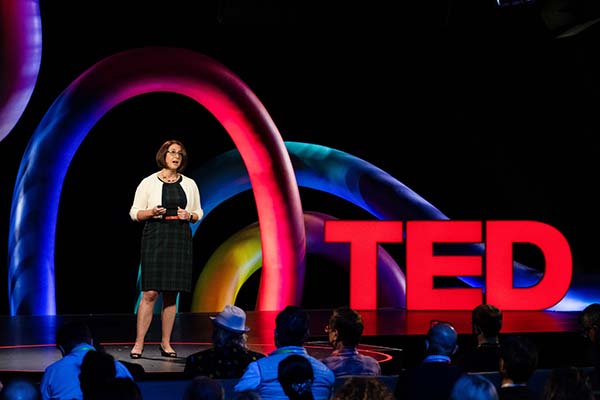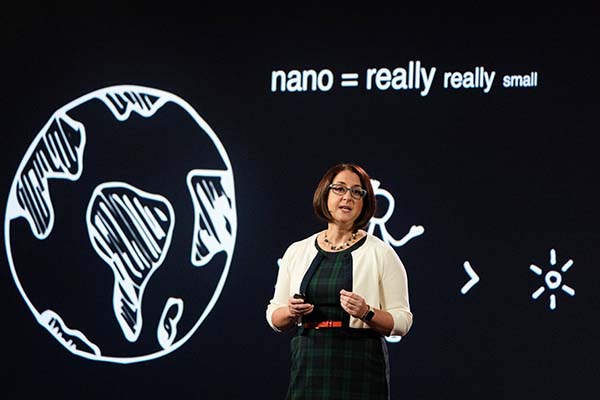Whitehead's TED Talk explains mRNA, delivers hope
Ryan Noone
Aug 9, 2021
When it comes to drug delivery methods, Carnegie Mellon Chemical Engineering Associate Professor, Katie Whitehead, is at the forefront of innovation.
Whitehead’s award-winning research has discovered ways to genetically engineer human cells in breast milk for infant disease therapy, uncovered a path for the oral delivery of insulin and pioneered RNA drug delivery techniques that will enable a new wave of treatments for nearly every known disease.
On August 2nd, Whitehead took the stage at the annual TED conference in Monterey, CA, to present her work around lipid nanoparticles and explain how RNA drugs are revolutionizing modern medicine.
“What if I told you the pandemic will save the lives of millions of people?” said Whitehead. “It’s a difficult thing to consider given how many loved ones we’ve already lost, but throughout the course of human history, massive public health crises have resulted in innovation in healthcare and technology.”

Source: TED
When the World Health Organization declared COVID-19 a global pandemic in March 2020, the dire need for a solution was apparent. Using mRNA delivery methods, scientists went to work, developing a vaccine in just 11 months, a process that had previously taken several years. So how did they do it?
According to Whitehead, scientists and engineers have been working for many years to get to the point where mRNA delivery methods could be used quickly in an emergency. More specifically, experts have been figuring out the delivery method’s biggest hurdle: directing mRNA drugs to the right places within the human body.
“When mRNA is administered, it’s injected into our muscles or our bloodstream, but we actually need it to go inside of our cells,” said Whitehead. “Unfortunately, mRNA is fragile, and our bodies will destroy it before it gets very far.”
“You can think of mRNA like a glass vase that you would like to send in the mail. Without a box and bubble wrap, it will break long before it is delivered; and without an address on the box, your postal delivery service will have no idea where to take it. So, if we are going to use mRNA as a therapeutic, it needs our help. It needs protection, and it needs to be told where to go.”
“Years ago, scientists had the idea to create lipid nanoparticles that would act like a Trojan horse,” said Whitehead. “Because the lipids in the nanoparticles look similar to the membranes that surround our cells, the cells are willing to bring the nanoparticle inside, and that’s when the mRNA are released.”
The mRNA acts as an instruction manual, telling cells to make a foreign protein, such as the coronavirus spike protein. When immune cells detect foreign proteins, they work to protect the body from them. The immune cells then “remember” the foreign protein so they can defend against it if it ever returns.

Source: TED
“As I speak, mRNA vaccines are out there saving lives from the coronavirus,” said Whitehead. “They offer our best hope of responding swiftly to viral variants because we can keep the lipid nanoparticles packaging the same and all we have to do is swap out the mRNA inside.”
“But here’s the best part- for mRNA therapeutics, these vaccines are only the beginning. It turns out that mRNA has the potential to treat many diseases.”
Whitehead explained that in the future, there will likely be treatments for cystic fibrosis, muscular dystrophy and sickle cell anemia, a cure for cancer, and vaccines that will protect against some of the world’s most deadly and feared pathogens, like Malaria, Ebola and HIV.
“Some of these products are already in clinical trials, and the success of the COVID-19 vaccines will pave the way for future generations of these therapies,” said Whitehead. “This is how the pandemic will save the lives of millions.”
“It catalyzed the most rapid vaccine development in history and brought to life a niche, previously unapproved form of technology. Now we are collecting long-term safety and efficacy data from hundreds of millions of people. With this data, interest for the technology, funding for the technology and trust in the technology will continue to grow.”
Media Contact:
Ryan Noone, rnoone@andrew.cmu.edu
